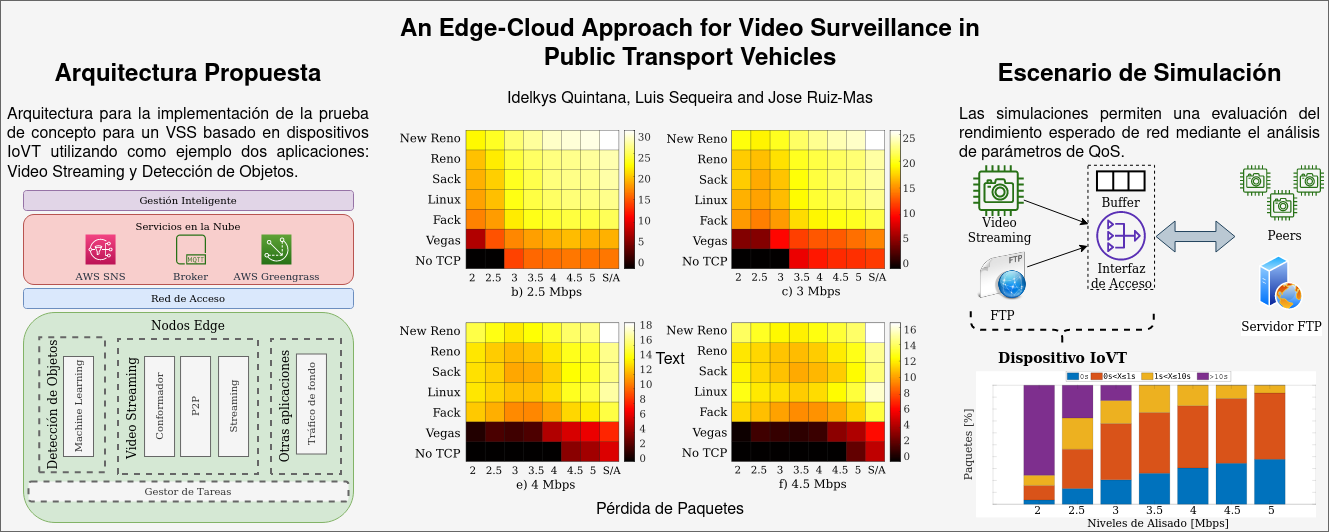An Edge-Cloud Approach for Video Surveillance in Public Transport Vehicles
Keywords:
Video Surveillance, Internet of Things (IoT), Internet of Video Things (IoVT), Edge Cloud, Peer-to-Peer (P2P) StreamingAbstract
A Video Surveillance System (VSS) is of primary importance in public transport hubs such as airports, train or bus stations but also inside the vehicle itself. In this paper, we present a heuristic architecture model for on-board video surveillance system based on Internet of Video Things (IoVT) devices which addresses the need for delivering smart video surveillance in public transport vehicles (e.g., buses) minimizing the impact on network performance. A proof-of-concept was implemented using a public Cloud Service Provider (CSP) and two Raspberry Pi as edge computing nodes. On the edge nodes, a Machine Learning(ML) application was deployed along with a network-efficient video streaming system. On the other hand, laboratory tests are included to understand the network traffic dynamic, furthermore results are enhanced with a set of simulations in order to analyze the performance of a video streaming application and6differentcongestion control algorithms in terms of packet loss and delay.
Downloads
References
N. Antonopoulos and L. Gillam,Cloud Computing: Principles, Sys-tems and Applications, ser. Computer Communications and Networks.Springer International Publishing, 2017.
S. Sans ́o, C. Guerrero, I. Lera, and C. Juiz, “A platform for lightweightdeployment of iotapplications based on a function-as-a-servicemodel,”IEEE Latin America Transactions, vol. 17, no. 07, pp. 1155–1162, 2019.
Z. Xiao, Q. Chen, and H. Luo, “Automatic scaling of internet applica-tions for cloud computing services,”IEEE Transactions on Computers,vol. 63, no. 5, pp. 1111–1123, May 2014.
S. Dhuria, A. Gupta, and R. Singla, “Review of pricing techniquesin cloud computing,”International Journal of Advanced Research inScience and Engineering, vol. 6, no. 10, pp. 1683–1690, June 2017.
O. Nassef, L. Sequeira, E. Salam, and T. Mahmoodi, “Building a lanemerge coordination for connected vehicles using deep reinforcementlearning,”IEEE Internet of Things Journal, pp. 1–1, 2020.
W. Shi, J. Cao, Q. Zhang, Y. Li, and L. Xu, “Edge computing: Visionand challenges,”IEEE Internet of Things Journal, vol. 3, no. 5, pp.637–646, 2016.
A. Sammoud, A. Kumar, M. Bayoumi, and T. Elarabi, “Real-timestreaming challenges in internet of video things (iovt),” in2017 IEEEInternational Symposium on Circuits and Systems (ISCAS). IEEE, 2017,pp. 1–4.
S.-T. Lin, Y.-H. Liao, Y. Tsao, and S.-Y. Chien, “Object-based on-line video summarization for internet of video things,” in2017 IEEEInternational Symposium on Circuits and Systems (ISCAS). IEEE, 2017,pp. 1–4.
Z. B. Babovic, J. Protic, and V. Milutinovic, “Web performance evalua-tion for internet of things applications,”IEEE Access, vol. 4, pp. 6974–6992, 2016.
A. Sammoud, A. Kumar, M. Bayoumi, and T. Elarabi, “Real-timestreaming challenges in internet of video things (iovt),” in2017 IEEEInternational Symposium on Circuits and Systems (ISCAS). IEEE, 2017,pp. 1–4.
Y. Mori, X.-T. Nguyen, and C.-K. Pham, “Reliable and energy-efficienttransmission on the internet-of-video-things,” in2017 17th InternationalSymposium on Communications and Information Technologies (ISCIT).IEEE, 2017, pp. 1–4.
A. Sammoud, A. Kumar, M. Bayoumi, and T. Elarabi, “Real-timestreaming challenges in internet of video things (iovt),” in2017 IEEEInternational Symposium on Circuits and Systems (ISCAS), 2017, pp.1–4.
“Ieee approved draft standard for low-rate wireless networks,”IEEEP802.15.4-REVd/D06, March 2020, pp. 1–945, 2020.
A. Betzler, C. Gomez, I. Demirkol, and J. Paradells, “Coap congestioncontrol for the internet of things,”IEEE Communications Magazine,vol. 54, no. 7, pp. 154–160, 2016.
T. Sultana and K. A. Wahid, “Choice of application layer protocols fornext generation video surveillance using internet of video things,”IEEEAccess, vol. 7, pp. 41 607–41 624, 2019.
J. Saldana, M. Suznjevic, L. Sequeira, J. Fernandez-Navajas, M. Matija-sevic, and J. Ruiz-Mas, “The effect of tcp variants on the coexistence ofmmorpg and best-effort traffic,” in2012 21st International Conferenceon Computer Communications and Networks (ICCCN), 2012, pp. 1–5.
L. Sequeira, J. Navajas, and J. Saldana, “The effect of the buffer sizein qos for multimedia and bursty traffic: When an upgrade becomesa downgrade,”KSII Transactions on Internet and Information Systems,vol. 8, pp. 3159–3176, 09 2014.
I. Quintana-Ramirez, A. Tsiopoulos, M. A. Lema, F. Sardis, L. Sequeira,J. Arias, A. Raman, A. Azam, and M. Dohler, “The making of 5g:Building an end-to-end 5g-enabled system,”IEEE CommunicationsStandards Magazine, vol. 2, no. 4, pp. 88–96, 2018.
I. Quintana, L. Sequeira, J. Fernandez, J. Ruiz, and J. Saldana, “Min-imizing the impact of p2p-tv applications in access links.”IEEE LatinAmerica Transactions, vol. 17, no. 02, pp. 183–192, 2019.
P. J. Braun, S. Pandi, R. S. Schmoll, and F. H. P. Fitzek, “On thestudy and deployment of mobile edge cloud for tactile internet usinga 5g gaming application,” inIEEE Annual Consumer CommunicationsNetworking Conference (CCNC), January 2017, pp. 154–159.
L. Sequeira, J. L. de la Cruz, J. Ruiz-Mas, J. Saldana, J. Fernandez-Navajas, and J. Almodovar, “Building an sdn enterprise wlan based onvirtual aps,”IEEE Communications Letters, vol. 21, no. 2, pp. 374–377,2016.


